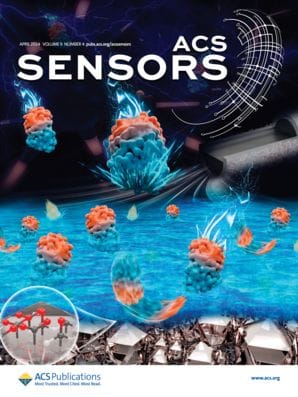Researchers have devised a new early warning system for catheter blockages: a polymer disk, placed in a urine collection bag, that releases a fluorescent dye. Visual confirmation of urinary tract infections involved with blocked catheters may help reduce antibiotic use or unnecessary procedures, the researchers say. The bacterium Proteus mirabilis causes 20 to 45% of catheter-associated urinary […]

Researchers have devised a new early warning system for catheter blockages: a polymer disk, placed in a urine collection bag, that releases a fluorescent dye. Visual confirmation of urinary tract infections involved with blocked catheters may help reduce antibiotic use or unnecessary procedures, the researchers say.
The bacterium Proteus mirabilis causes 20 to 45% of catheter-associated urinary tract infections. When these bacteria infect a bladder, they secrete an enzyme that breaks down urea, a metabolic by-product in urine, into ammonia. Ammonia increases the pH of urine, which allows magnesium and calcium minerals to form in the bladder. For some patients with long-term catheters—left in for more than 30 days—these solid mineral particles can clog a catheter tube, leading to bladder blockage and potentially fatal infections.
Researchers have looked for a reliable and accurate way to predict blocked catheters by placing sensors in a catheter line to provide a colored signal when urine pH increases. However, these devices leaked or were difficult to make.
A. Toby A. Jenkins of the University of Bath and his colleagues wanted to provide an early warning of potential catheter blockage using a device that could easily be used in all existing catheter equipment. The researchers designed a double-layered polymer disk to release a fluorescent molecule in liquid with elevated pH.
First, they packed the fluorescent dye 5(6)-carboxyfluorescein inside a soft disk of polyvinyl alcohol. Then they surrounded the dye-filled disk with a hard, pH-sensitive copolymer that is commonly used to coat pharmaceuticals, prevent their dissolution in the stomach, and slow their release in the colon.
To test the sensor, the researchers placed the 2.5-cm-diameter disk in simulated urine with P. mirabilis. The pH of the liquid increased as the bacteria grew and secreted their ammonia-producing enzyme. As the pH of the artificial urine surpassed 7, the outer coating of the disk swelled, allowing the green fluorescent dye to seep out of the center of the disk.
Then the researchers placed the disk in simulated urine with Escherichia coli bacteria that do not produce an enzyme that raises the pH of the liquid. The dye remained inside the disk, leaving the liquid uncolored.
Next, the researchers tested the disk using a simulated bladder and commercial catheter equipment. The researchers placed two polymer disks in a plastic collection bag and connected the catheter to a warmed glass vessel containing artificial urine, simulating a bladder. After adding P. mirabilis to the vessel, the artificial urine collected in the catheter bag turned green about 14 hours before minerals blocked the catheter. This advance notice provides patients or caregivers enough time to change the tube, Jenkins says.
“I think the primary benefit of these sensors is reassurance that nothing is going wrong,” Jenkins says. Knowing that there is no impending catheter blockage can help reduce unnecessary catheter changes or avoid antibiotics prescribed to halt a suspected infection. Jenkins says his team is working to miniaturize the disk so that it can be slipped easily into existing catheter bags.
Jennifer Meddings, a health services researcher and internist at the University of Michigan, notes that long-term catheterization is not as common in the U.S. as it used to be. For those patients with long-term catheters, many have urinary systems chronically colonized with bacteria that can increase urine pH, though they may not have symptoms of infection. She wonders if chronic colonization increases urine pH enough to release dye from these disks, providing a signal for a situation that does not warrant antibiotic treatment. Dye released only upon acute infection with bacteria, rather than long-term colonization, would likely be the most meaningful signal for patients prone to blockage in their long-term catheters, Meddings says.
This article is reproduced with permission from C&EN (© American Chemical Society). The article was first published on March 30, 2018.
